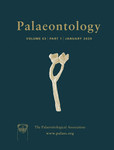Reg. Charity No. 1168330

While it is well established that the shapes and sizes of shells are strongly phylogenetically controlled, little is known about the phylogenetic constraints on shell thickness. Yet, shell thickness is likely to be sensitive to environmental fluctuations and has the potential to illuminate environmental perturbations through deep time. Here we systematically quantify the thickness of the anterior brachiopod shell which protects the filtration chamber and is thus considered functionally homologous across higher taxa of brachiopods. Our data come from 66 genera and 10 different orders and shows well‐defined upper and lower boundaries of anterior shell thickness. For Ordovician and Silurian brachiopods we find significant order‐level differences and a trend of increasing shell thickness with water depth. Modern (Cenozoic) brachiopods, by comparison, fall into the lower half of observed shell thicknesses. Among Ordovician–Silurian brachiopods, older stocks commonly have thicker shells, and thick‐shelled taxa contributed more prominently to the Great Ordovician Biodiversification but suffered more severely during the Late Ordovician Mass Extinction. Our data highlight a significant reduction in maximum and minimum shell thickness following the Late Ordovician mass extinction. This points towards stronger selection pressure for energy‐efficient shell secretion during times of crisis.